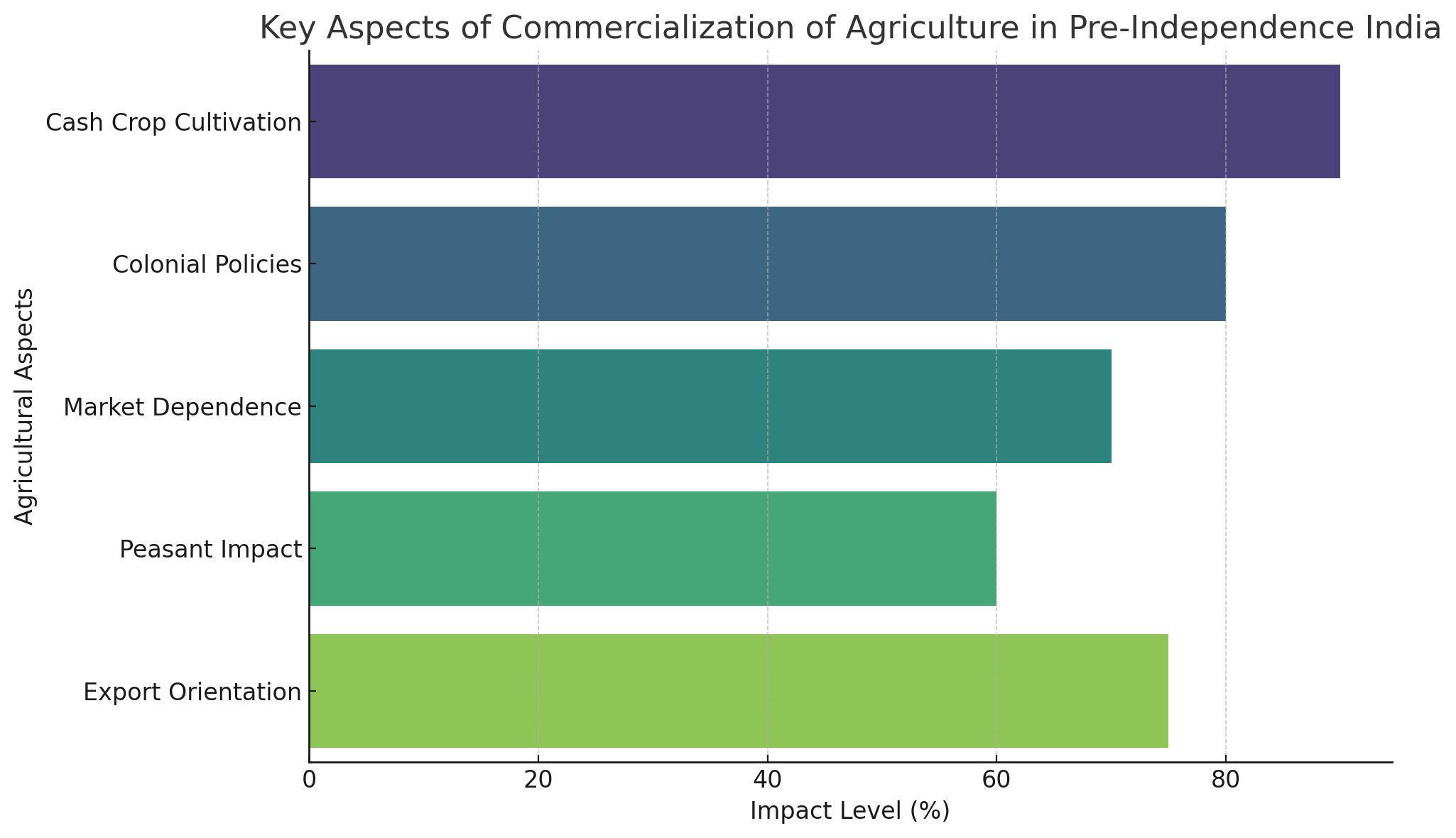
30 Jul Commercialization of Agriculture in Indian Economy Pre-Independence Era
Commercialization of Agriculture in Indian Economy Pre-Independence Era
Introduction
The commercialization of agriculture during the pre-independence period in India refers to a significant transformation from subsistence farming to market-oriented production. Under colonial rule, Indian agriculture experienced profound structural shifts which were driven primarily by British imperial interests. The transition disrupted traditional agrarian economies and had far-reaching implications for peasantry, land relations, and rural indebtedness.
Definition and Understanding
Commercialization of agriculture is the process wherein agricultural production is governed by market forces rather than subsistence needs. In British India, this meant growing crops for sale in national and international markets, especially cash crops such as indigo, cotton, jute, and opium. The farmer was no longer producing for his own consumption but to fulfill demands driven by colonial trade policies.
Historical Context
Before British colonization, Indian agriculture was largely self-sufficient. Crops were grown primarily for local consumption, and the economy was village-based. However, with the advent of British rule and the integration of India into the world capitalist economy, agriculture was increasingly restructured to serve the needs of industrial Britain.
- British Industrial Revolution: Created demand for raw materials like cotton and jute from colonies.
- Land Revenue Settlements: The Permanent Settlement (1793), Ryotwari (Madras, Bombay), and Mahalwari systems ensured fixed revenue collection, compelling peasants to grow cash crops to meet tax demands.
- Infrastructure: Railways and ports facilitated long-distance transportation of cash crops, not food grains.
Features of Commercialization
- Cash Crop Cultivation: Expansion of crops like cotton, jute, tea, coffee, indigo, and opium.
- Market-Oriented Production: Shift from self-sufficiency to profit-driven cultivation.
- Rural Indebtedness: Moneylenders replaced traditional community finance, leading to debt traps.
- Export-Oriented Economy: Agriculture was realigned to suit British export needs.
- Neglect of Food Crops: Led to periodic famines and malnutrition.
Factors Leading to Commercialization
1. British Land Revenue Systems
The Permanent Settlement in Bengal, Ryotwari in Madras and Bombay, and Mahalwari in UP altered the nature of landownership. Zamindars and ryots were required to pay fixed land revenue, compelling them to maximize income via market crops.
2. Trade and Industrial Interests of Britain
Britain needed raw materials for its textile industries and India was turned into a supplier of cotton, jute, and indigo. Colonial policies like the Opium monopoly were enforced to feed Chinese trade.
3. Expansion of Transport Infrastructure
British-constructed railways and roads enhanced the connectivity of hinterlands to ports, facilitating the transport of commercial crops. However, this infrastructure was not geared toward famine relief.
4. Growth of Internal and International Market
The commercialization was driven by the integration of Indian agriculture into global markets, with price fluctuations dependent on international trends.
Major Commercial Crops and Their Impact
- Indigo: Forced cultivation led to the Indigo Revolt of 1859-60. Planters used oppressive contracts.
- Cotton: Demand surged during the American Civil War, but declined later, leaving farmers in distress.
- Jute: Eastern India saw massive jute cultivation but peasants remained impoverished due to exploitative pricing.
- Opium: Grown mainly in Bihar and UP, and exported to China under monopoly, contributing to social decay.
Social and Economic Impacts
1. Peasant Distress
Commercialization increased reliance on moneylenders. Crop failures or price crashes led to indebtedness and land loss.
2. Famines and Food Insecurity
With focus on cash crops, food grains were neglected. This resulted in frequent famines such as the Great Famine of 1876–78 and Bengal Famine of 1943.
3. Decline of Village Industries
Handicrafts declined due to cheap British imports, making villagers more dependent on agriculture.
4. Rise of Moneylenders and Absentee Landlords
The weakening of community-based support and rise of exploitative intermediaries destroyed rural resilience.
Case Studies
Indigo Rebellion (1859–60)
Farmers in Bengal revolted against European planters who forced indigo cultivation. It highlighted rural exploitation and eventually led to some reforms.
Deccan Riots (1875)
Farmers in Maharashtra attacked moneylenders due to land dispossession. This exposed the exploitative nature of agrarian credit.
Mind Map
commercialization agriculture
Conclusion
The commercialization of agriculture under colonial rule was an exploitative transformation designed to serve imperial needs. While it introduced market forces and transport networks, it simultaneously led to rural indebtedness, loss of food security, and peasant impoverishment. This dual legacy makes it a critical area of study in understanding the political economy of pre-independence India.
Previous Year Questions (PYQs)
- Discuss the factors that led to the commercialization of Indian agriculture during the British period. (UPSC CSE 2017, 10M)
- What were the economic consequences of commercialization of agriculture in colonial India? (UPSC CSE 2014, 15M)
- Explain the impact of British land revenue systems on Indian agrarian society. (UPSC CSE 2012, 12M)
Probable Questions for Upcoming Exams
- Evaluate the impact of colonial infrastructure on agricultural commercialization in India.
- How did the commercialization of agriculture contribute to rural indebtedness and famines?
- To what extent was the commercialization of agriculture responsible for social unrest in colonial India?
- Compare the outcomes of Permanent Settlement and Ryotwari system in the context of agricultural commercialization.




No Comments